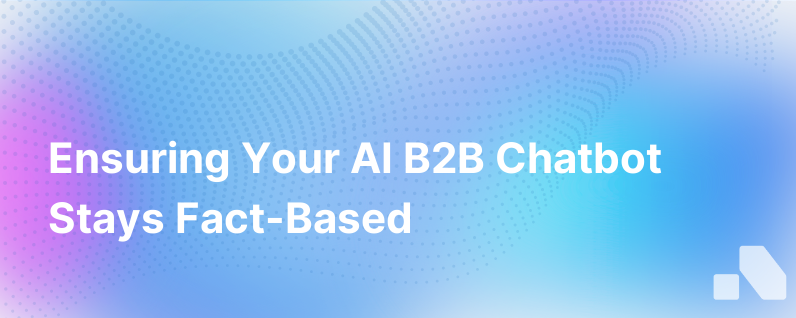
In the rapidly evolving domain of artificial intelligence, chatbots have become a go-to solution for many B2B businesses seeking to streamline customer communication. AI-powered chatbots are designed to offer automated responses that mimic human conversational capacities, ensuring that no customer inquiry goes unnoticed. However, an issue that inherently arises with AI-driven communication tools is their propensity to fabricate responses, a situation also known as 'hallucination.' This can not only derail customer service efficiency but also harm a company's credibility. To ensure that your B2B chatbot serves with precision and integrity, we must address this challenge head on.
In this nuanced exploration, we'll delve into tactics and best practices that prevent your AI-powered B2B chatbot from making things up, thereby enhancing the accuracy and reliability of your digital interaction efforts.
Understanding AI "Hallucination"
AI hallucination occurs when the bot generates responses based on patterns it has learned, rather than factual data or pre-defined rules. This can lead to the dissemination of erroneous information or the bot exhibiting confidently misplaced creativity, which is not desirable in a business environment where accurate data and reliable guidance are paramount.
Training Data: The Bedrock of Reliability
The foundation of a trustworthy chatbot lies in the quality of its training data. Your AI model is only as reliable as the dataset on which it was trained. Here are the steps to take:
- Curate High-Quality Data: Ensure that the dataset used in training your chatbot is not only vast but meticulously annotated and devoid of inaccuracies.
- Diversity in Data Sources: Draw from diverse data sources to prevent overfitting to particular communication styles or domains which can limit the bot's versatility.
- Continuous Data Updates: Regularly update the dataset with new interactions. This helps the chatbot stay relevant and avoid propagating outdated or incorrect information.
Algorithmic Decisions: Balancing Creativity with Caution
The AI algorithms define how your chatbot processes information and generates responses. The key is to choose algorithms that strike a balance between generating natural-sounding dialogue and restraining creativity where factual accuracy is needed. Here's how:
- Contextual Understanding: Opt for models that are adept at understanding context. Natural Language Processing (NLP) advancements, such as Transformers like GPT-3, are particularly adept at this.
- Response Guardrails: Implement clear parameters within which the AI operates, defining the scope, tone, and limits of its responses.
- Confidence Thresholds: Define and continually refine confidence thresholds, which determine how sure the chatbot is about its response before it replies. Uncertain responses should prompt escalation to a human agent.
Monitoring and Feedback: Essential Pillars of AI Integrity
Once your chatbot is deployed, the work is far from over. Active monitoring ensures the bot adheres to factual rigor, and feedback mechanisms correct course when needed. Here's what to set up:
- Real-Time Monitoring: Use tools to monitor chatbot interactions live or review logs to spot any deviations from pre-determined response patterns.
- Feedback Loops: Allow users to signal errors or low-quality responses, and incorporate this feedback into your training data to adjust the AI's expressions.
- Human Oversight: Have a dedicated team to periodically evaluate chatbot performance, making necessary calibrations and ensuring consistent oversight.
Update and Evolution: The Circle of AI Life
AI is not a set-and-forget technology; it requires an iterative approach to stay aligned with your business objectives. Here’s what that entails:
- Regular Evaluation: Periodically assess the chatbot against an evolving checklist of accuracy, customer satisfaction, and relevance.
- Fine-Tuning the Model: Make adjustments to the AI model with new data, reflect on customer interactions, and address nuances discovered through usage.
- Version Control: Keep track of updates and improvements to revert to previous models if newer iterations introduce issues.
Advanced Techniques: Fine-Tuning AI Performance
Advanced methods can also play a significant role in fine-tuning your chatbot's performance:
- Supervised Learning: Continue to train your chatbot with supervised learning where human agents validate and correct its responses.
- Transfer Learning: Apply pre-trained language understanding models and tailor them further to your industry-specific needs.
- Rules-Based Triggers: For specific subject domains known to cause difficulty, implement rules-based triggers that route inquiries to human agents.
Implementing these strategies is crucial to maintaining the reliability of your AI-driven chatbots. In addition to these technical considerations, keeping your chatbot from making things up requires a fully integrated organizational approach where everyone from data scientists to sales representatives plays a role.
AI chatbots represent a robust tool for enhancing B2B interactions and engagement. By coupling them with vigilant, iterative oversight and continuous refinement, you can ensure they deliver reliable, accurate support aligned with your business’s values and objectives. From the meticulous preparation of datasets to advanced machine learning techniques and ongoing human supervision, each step is a stride towards ensuring that your B2B chatbot remains a trustworthy front-line ambassador of your company.